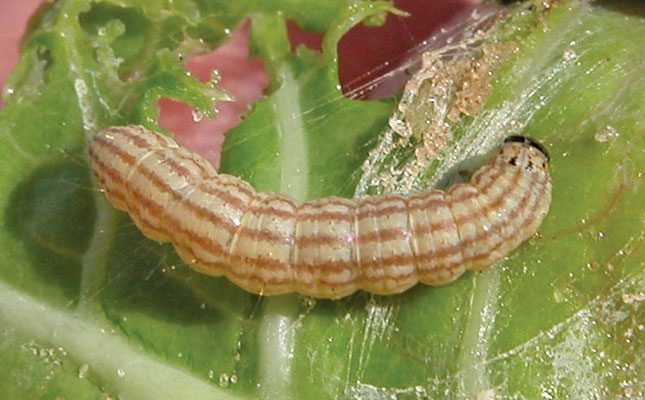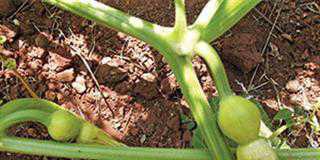
Photo: www.ent.uga.edu
This is present only during the warmer months. The caterpillar is 12mm to 15mm long and yellowish-tan with light brown longitudinal stripes and a black head. A single webworm can ruin a head of cabbage. It attacks the growing tip of young plants. The first sign of its presence is webbing in the centre of the plant. Look more closely and you will see the caterpillar boring into the stem from the growth tip. It can also enter the midrib near the base.
I have tried a number of products and have had success with only one: the systemic mevinphos. This is mainly because the webworm seldom eats the leaves or exposes itself so that it can be reached by spraying. On rare occasions, with a heavy outbreak, it may pay to use a knapsack sprayer and direct the spray into the growing tip area. This goes relatively quickly – it is possible to cover 1ha in a day.
Semi-looper and wasp control
The cabbage semi-looper (Trichoplusia ni) is another caterpillar that comes and goes. It is green with longitudinal white stripes and walks in a looping manner, which gives the pest its common name. On rare occasions it can occur in large numbers. This is because it is naturally controlled by a highly effective parasitic wasp. So effective are these wasps that they destroy all the semi-loopers in the area and then die out on account of a lack of hosts to breed upon.
Semi-looper caterpillars can feed on a number of plant species. A few years ago, they had built up into huge numbers and had even started defoliating carrot crops. The moth has a golden patch on each wing. They are nocturnal, but can be flushed from the crop when you walk through the land during the day. If you see many of these moths, keep a lookout for damage to other crops, and spray your cabbages with a soft product that will not kill the parasitoids.
I once came across a fully grown semi-looper with a tiny, stumpy parasitic wasp sitting on its back. I noticed that it had inerted its ovipositor into the caterpillar. After a few minutes, the parasitoid flew off and I collected the caterpillar, placed it in a small box, and peeked at it from time to time. Soon the entire caterpillar took on a granular appearance as the wasp larvae pupated in the now- mummified creature.
I removed the lid after a few weeks, and a swarm of parasitc wasps flew out. This parasitoid, in common with the species that parasitise the potato tuber moth, lays eggs that sub-divide into a large number of larvae. These are called poly-embryonic types. In the case of the semi-looper, 3 000 parasitoids can emerge from a single larva. It is easy to see how just a few of these parasitoids can in a very short time virtually eliminate the pest.
A rare pest on the highveld
Spodoptera is a caterpillar I rarely see on cabbage in the Highveld, but I have encountered it in the Mpumulanga lowveld. It looks similar to a cutworm but is fatter and more blocky. It damages cabbage heads in the same way as bollworms. The moths also have a similar appearance to the cutworm moth.
The search for parasitoids
The economic importance of parasitoids and the continual search for them was illustrated to me years ago while I was growing vegetables for a large estate. An Israeli researcher showed me photographs of a certain pest and asked if I had ever come across it. I said it was only a minor pest here; in Israel, apparently, it was a much greater threat.
The researcher said enthusiastically that the fact that it was a minor pest here meant that there had to be natural control. He asked me to collect the caterpillars whenever possible and send them to Israel in the hope that they had been stung by parasitoids and Israeli scientists could make use of this natural control there. Remember, wherever possible, use ‘soft’ insecticides that kill the target pest while preserving its natural enemies.












